Getting rid of cabbage worms can be a constant battle for many home gardeners. But you can easily control them without spraying nasty chemicals on your vegetables, and it IS possible to eliminate them from your plants for good!
In this post, you’ll learn all about their life cycle, feeding habits, the damage they cause, how to identify them, and where they come from.
I’ll also share tons of tips and natural methods that you can use to get rid of cabbage worms in your garden organically.
What Are Cabbage Worms?
Cabbage worms are the larvae of a butterfly called “cabbage whites”, “cabbage white butterfly”, or “small whites”.
They get their common name because they prefer eating crops in the Brassicaceae, aka cabbage, family of plants. Cruciferous vegetables are their main host plant.
Related Post: How To Control Garden Pests Naturally

What Do They Look Like?
Cabbage worms are small, green caterpillars that start out tiny and grow to be about an inch long.
They’re soft-green in color, covered in tiny hairs, and have a faint yellow line running down their back and sides. They have legs all along their body, so they stay flat when they crawl, rather than bending like an inchworm.
In their adult form, they’re small white moths with a wingspan of only about 1.5 – 2 inches. They have a couple of black or brown spots on their wings, and can also appear to be pale yellow or light tan in color.
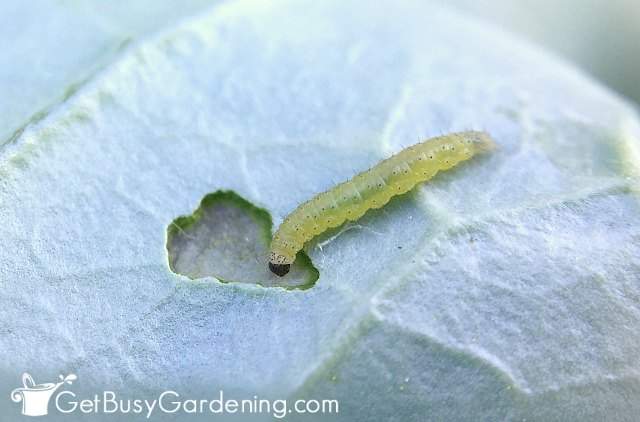
Cabbage Worm Life Cycle
Understanding the cabbage worm life cycle is important to help you get rid of them quickly, and prevent major damage to your plants.
They hibernate through the winter as pupae, and emerge as adult butterflies in the spring. The adults look harmless, and they are. In fact, they’re beautiful as they gracefully flutter and float around the garden.
However, once you realize why they’re fluttering around (ehem, laying eggs), they don’t look so pretty anymore. Shortly after emerging, the females will get busy laying eggs.
The eggs can be white, yellow, or green, and are so tiny that they’re barely visible to the naked eye. After a few days, baby caterpillars will hatch to start feeding on the plant.
After about 3 to 4 weeks of feeding, and once the cabbage worms are full-sized, they will pupate. At this point, they form cocoons (called a chrysalid) on the undersides of leaves. New adults will emerge from the chrysalis in about 10 days. There can be multiple generations in one season.

Where Do They Come From?
Since the adults can fly, cabbage worms could come from anywhere. They are naturally attracted to cole crops, since that’s their main host plant.
So, if they are present in your area of the world, and you’re growing cruciferous veggies, then it’s a sure bet that they will find your garden.
What Do Cabbage Worms Eat?
They mostly eat plants in the Brassicaceae family, so you could find the caterpillars feeding on any type of cruciferous vegetable.
Some of their favorites are cabbage, mustard greens, bok choy, kohlrabi, brussels sprouts, kale, cauliflower, broccoli, turnips, radishes, and collard greens.
But it’s not uncommon to find cabbage worms on other types of veggies, and sometimes even flowers (they love my nasturtiums).
Oh, and by the way, cabbage worms don’t change colors when they eat purple veggies (just in case you were wondering, because I used to!). They always stay green, no matter what they eat.
Related Post: How To Grow Cauliflower
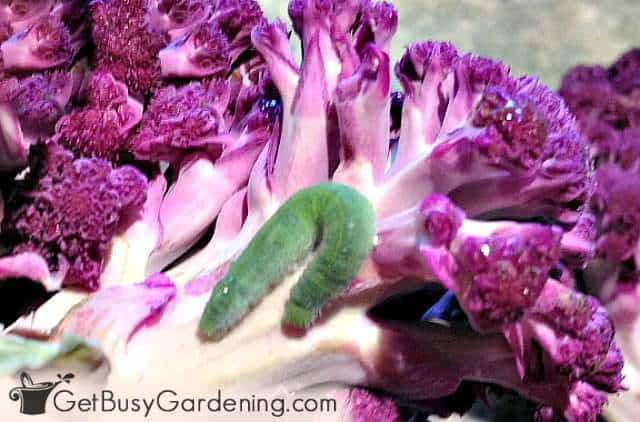
Types Of Damage They Cause
The first sign of cabbage worm damage is holes in the leaves. The caterpillars eat uniform holes between the veins and stems, eventually skeletonizing the leaves. Large populations can defoliate a plant very quickly, especially seedlings or small starts.
Established plants can withstand minor damage without worry. But severe damage can stunt their growth, and they may not produce a head. Plus, your leafy harvests will be destroyed.
Unfortunately, the caterpillars can also feed on the heads of your veggies. They will sometimes even bore into the heads, causing major damage, or even destroying your crops.
So, once you start seeing holes in the leaves, you should take swift action to get rid of the cabbage worms as quickly as possible.
Related Post: How To Grow Brussels Sprouts
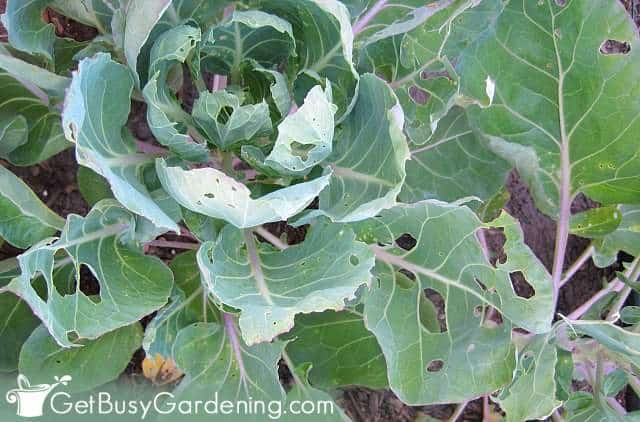
How To Get Rid Of Cabbage Worms Naturally
The great news is that there are several organic methods you can use for controlling cabbage worms. So you won’t have to worry about using any toxic chemical pesticides on your vegetables.
Keep in mind that it will take more than one treatment to get them under control, so it’s important to be persistent. You should also use a combination of the methods for the fastest results.
Related Post: Natural Garden Pest Control Remedies & Recipes
Hand Picking
One of the best, most natural ways for treating cabbage worms is to hand-pick them off your plants. This sounds like a lot of work, and it can be at first. But if you’re diligent, the problem will go away pretty quickly.
The caterpillars are really good at camouflage. They’re almost the same color as the leaves, and tend to feed on the undersides. So it can be difficult to spot them at first – especially when they are tiny babies.
You’ll probably see their frass (aka poop) first. It looks like green sawdust or small green balls near the holes in a plant, or on the leaves below. Flip the holy leaf over, and you’ll likely find the culprit(s).
They don’t bite or sting, so you can pick them off with your bare hands. But if that grosses you out, then wear gloves. You should also pick off any eggs or cocoons that you find while you’re hunting for the caterpillars.
You can simply drop them into a bucket of soapy water to kill them. They can’t swim, and will eventually drown, but the soap will kill them much faster. Of course you can always just smush them, if you aren’t too squeamish.
Related Post: How To Grow Broccoli
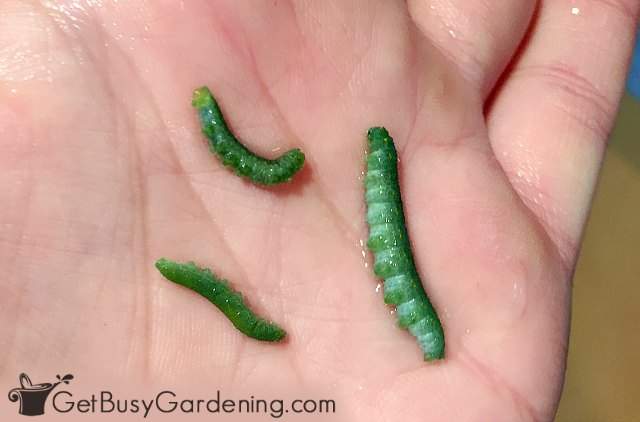
Neem Oil
Neem oil is a natural pesticide that kills the caterpillars when they feed on the leaves, and it’s safe to use on vegetables. It has a residual effect too, which means you don’t have to spray your plants every day.
It doesn’t kill the cabbage worms instantly, it takes a while for it to get into their systems, but it is very effective for long-term control. Learn how to use neem oil on your plants here.
Bacillus Thuringiensis (BT)
Bacillus thuringiensis (BT) is a naturally occurring soil-dwelling bacterium commonly used as a biological insecticide. BT works great for getting rid of cabbage worms.
Simply spray it on the leaves of your infested plants. When the caterpillars eat it, they’ll stop feeding right away. Though it can take a few days for them to die.
Insecticidal Soap
Insecticidal soap will kill the larvae on contact. So this is a good alternative if you’re too squeamish to hand pick them. It only works when you spray it directly on the cabbage worms, and has no residual effect.
You can either buy a pre-made organic insecticidal soap, or make your own by mixing 1 teaspoon of mild liquid soap with 1 liter of water.
Spray the leaves as soon as you start seeing damage, the soap will destroy both the eggs and the tiny caterpillars. Be sure to spray under the leaves too, since that’s usually where they hide.
Related Post: How To Grow Kohlrabi
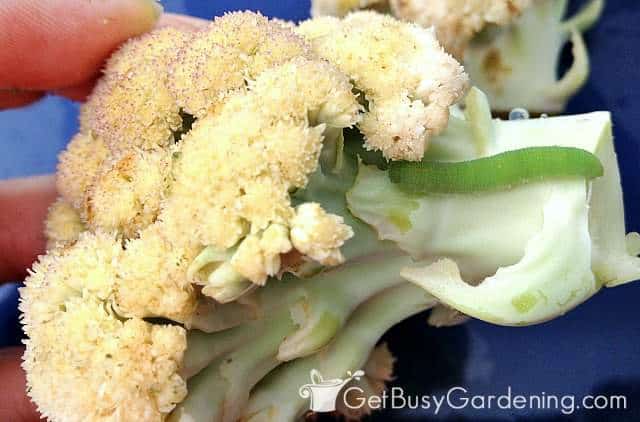
How To Prevent Cabbage Worms
One of the most effective ways to get rid of cabbage worms in your garden is to prevent them from infesting your plants in the first place. Below are the best methods to use.
Use Row Covers
Since brassicas don’t require pollination, floating row covers are an excellent way to prevent the female butterflies from laying their eggs on your plants.
You can cover your crops right after you plant them, and leave them that way all summer long. If you don’t get them installed right away, you can add them at any time. Just keep an eye on the plants after you cover them, and remove any existing caterpillars right away.
Since the floating row covers are lightweight, they allow plenty of sunlight and water through, so the plants will grow just fine. You can simply adjust them as the plants get larger, if necessary.
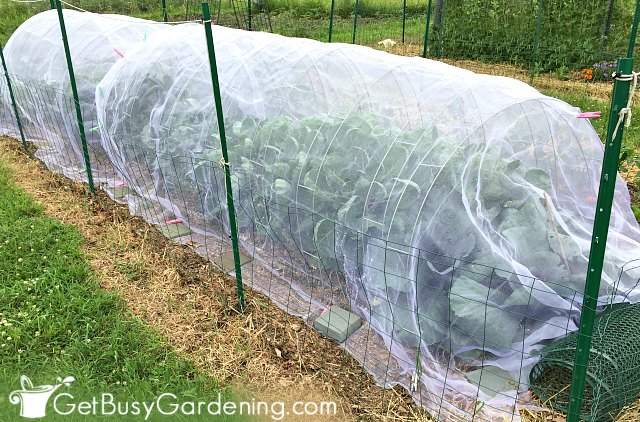
Attract Beneficial Predators
Beneficial bugs, like wasps, ladybugs, spiders, ground beetles, and praying mantis, are excellent natural predators. Birds also enjoy feasting on caterpillars, and they can eat a lot of them.
So you should work to attract them to your garden to help in your fight. The easiest way to do that is interplanting flowers and host plants in and around your veggie beds, and making your garden bird-friendly.
Clean Up Your Garden In The Fall
As I mentioned above, cabbage worms overwinter in their pupa stage, and they hibernate in plant debris or the soil. So here are a few things you can do in the fall to help prevent them next year:
- Remove all of the dead plant material, especially anything in the cabbage family. Be sure to destroy it, or throw it into the trash, rather than putting it into your compost bin. Otherwise, the pupae can just overwinter in there.
- After cleaning out your garden in the fall, till or turn the soil. This will destroy the hibernating pupae or expose them so that predators can eat them.
Cabbage Worm FAQs
To get rid of cabbage worms before cooking, you can simply soak the leaves or heads in water for 5-10 minutes. The caterpillars will drown and sink to the bottom. Be sure to completely submerge everything so the worms can’t crawl on top, and use a heavy plate or bowl to weight down any floating pieces.
Birds and predatory insects, like spiders, wasps, ground beetles, and ladybugs love eating cabbage worms and eggs.
No. As disgusting as it would be to know that you accidentally ate a cabbage worm, they are not poisonous or harmful if eaten. Think of it as added protein.
Getting rid of cabbage worms in your garden can be frustrating, and it may take a little bit of trial and error to figure out which control methods work best. But if you are diligent with your treatments, your problem will go away pretty quickly.
If you’d like to learn how to make the most of your space and get as much homegrown food as possible, then my Vertical Vegetables book is perfect! It will teach you all you need to know, has tons of gorgeous photos, and includes 23 DIY projects you can build for your own garden. Order your copy today!
Learn more about my Vertical Vegetables book here.
Share your tips and methods for getting rid of cabbage worms in the comments section below.
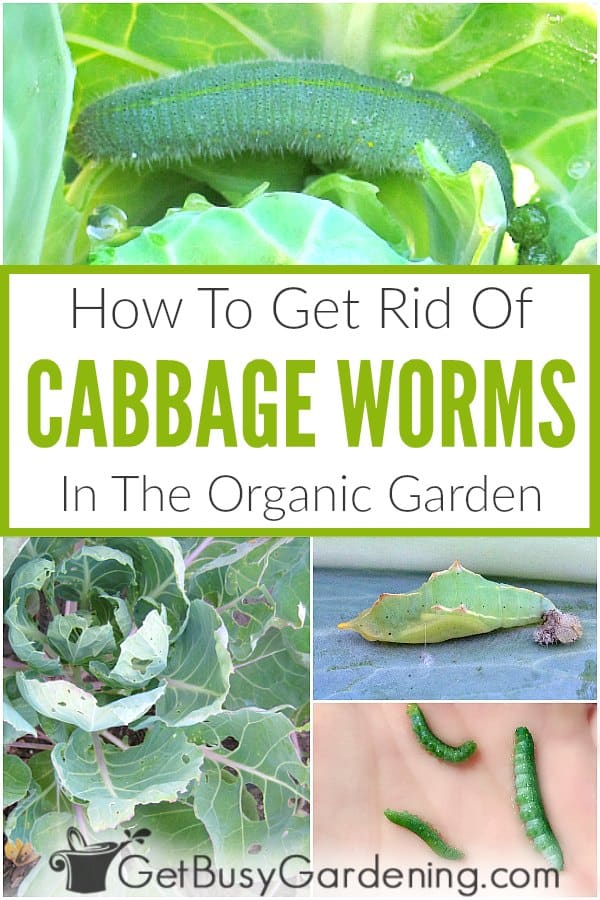
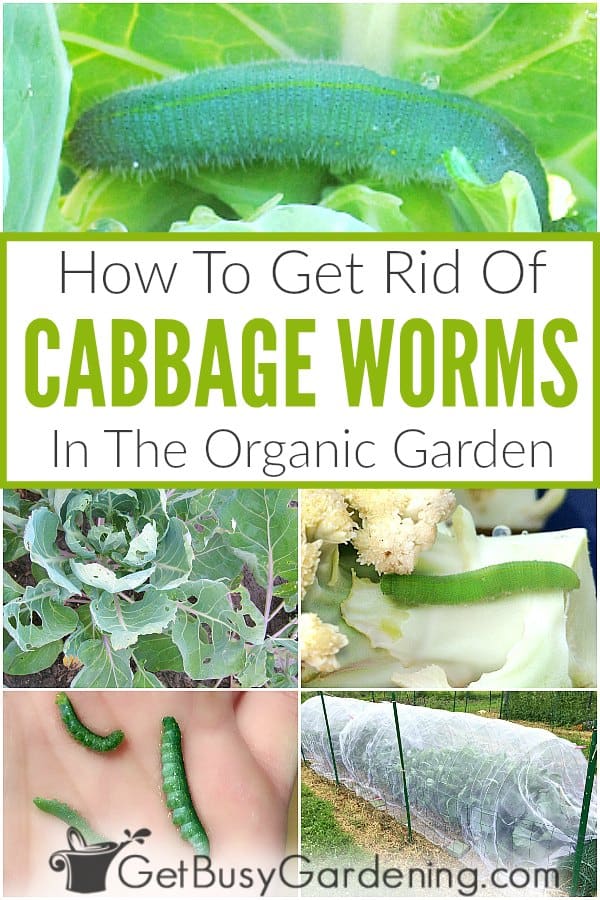
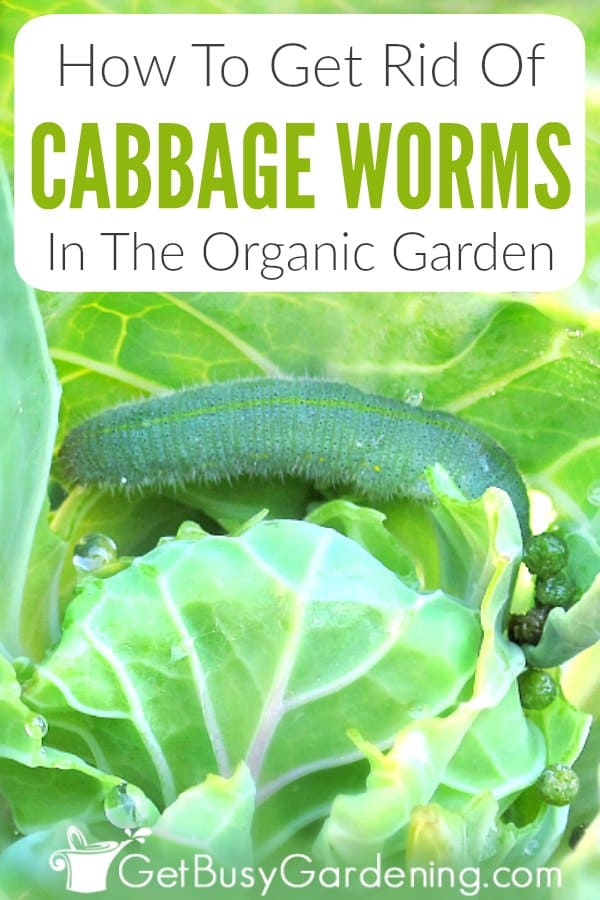




Angie says
We lost our crops this summer (collar greens. lettuce etc). This was the first time this has happened in our raised bed garden, and first time we’ve seen these green little creatures on the leaves. Everything was pulled out the garden and thrown out. What can we do to get ahead of this for next year for the soil?
Amy Andrychowicz says
Clearing the debris in the fall and then tilling or turning your soil, and then tilling/turning it again in early spring, will help to kill the cabbage worms that overwinter in your garden. You can also toss the infested plant material into the trash or commercial compost bin rather than into your garden compost bin to prevent them next year. Good luck!
William says
You know Amy , I’ve been gardening for many years in Tennessee and we had some problems with cabbage worms but since I’ve moved to West Virginia I’ve never seen so many holes in the leaves .. . Looks like Morris code .. but funny thing is the red cabbage I planted last year had no holes just the green. Do these worms not feed on the red cabbage?
Amy Andrychowicz says
Yes! Cabbage worms do tend to favor green over red cabbage, so planting red varieties instead of green is a great way to avoid issues with these pesky bugs.
Mary Kay Brewster says
I just wanted to say thanks for the excellent, informative article you wrote. I’m on a mission to deworm my kale! Thannk you!
Amy Andrychowicz says
You’re welcome! De-worming your kale is definitely doable.
jim bertilson says
I have green worms, but i also have ones that are more black and yellow horizontal stripes. What are these?
Amy Andrychowicz says
If they are feeding on your cole crops, then they are either cabbage worms or cabbage loopers. Treatment is the same for both. 🙂
Lorraine says
Regarding soap spray for caterpillars, will it also kill good bugs? And will it make the veggies taste like soap?
Will row covers help even if the grubs are in the soil? My cabbages are already infested!
Amy Andrychowicz says
The soapy spray will only kill the good bugs that you spray it on directly, there is no residual effect. So, as long as you don’t spray it directly on the good bugs, then it will not harm them. The veggies won’t taste like soap unless you eat them right after spraying, without rinsing them first. Cabbage worms are caterpillars, NOT grubs, and they do not live in the soil, so there’s no concern there. However, if the female lays her eggs on the plant before you install the row covers, then it is possible the caterpillars will hatch under them. To avoid this, make sure you install your row covers as soon as you’re done planting.
Lara Kaye says
Any thoughts on what is going on when the cabbage worm looks like it is in a white web on the backside of the leaf, has it been trapped by something else or is it in an early stage of turning into the cocoon to form a moth? I thought I read something about a predictor insect that might be in this web/casing and to leave them… Any ideas?
Amy Andrychowicz says
Yes, that is the early stage of their cocoon. Cabbage loopers attach themselves to the undersides of leaves with that silky cocoon you describe, right before they pupate.
Gayle Davis says
I found brown at the base of my bok choi plant.ig looked like something had eaten it.
I am new to raised bed gardening or any type of gardening.
I can’t find a picture like it on the computer.
Amy Andrychowicz says
That definitely doesn’t sound like cabbage worms, because they are green worms that eat holes in the leaves of plants in the cabbage family. It could have been caused by slugs. Here’s an article about how to find and get rid of slugs.
Nancy says
Hi –
What do I do if I find a cabbage worm once the cauliflower is cooked? Is the whole dish garbage?
Thank you!
Amy Andrychowicz says
LOL, well that depends on how you feel about it. Personally, I would just pick out the dead cabbage worm, and move on. I don’t like to waste food, and since it came from my garden, then it’s not a big deal to me to just pick out a dead cabbage worm once and a while. (now if it was in food I bought from the store, that would be a different story, HAHA! 😉 ). Truth be told, I’m sure I’ve unknowingly eaten more than one in my life.
In the future, you can soak the veggies in water for 15 minutes to drown any cabbage worms that may be on them after you bring them indoors. They will sink to the bottom of the water, and you won’t have as much worry about finding them later on.
Nancy says
Thank you! I’ll do that.
Amy Andrychowicz says
You’re welcome!
Julie says
Wow, this is exactly what is happening to our wintersown cabbage. I just saw the little green cabbage worm buggers today. We have lots of chewed on leaves and no head of cabbage. Darn it@!
Amy Andrychowicz says
Ugh, sorry to hear that your plants are infested with cabbage worms. Bummer! But now that you know the culprit, you can get rid of them pretty quickly, and hopefully save your cabbage harvest!